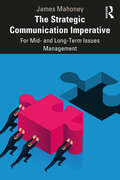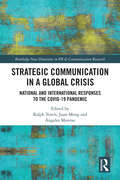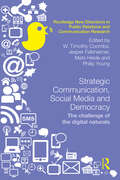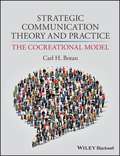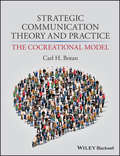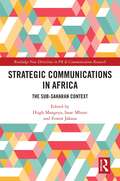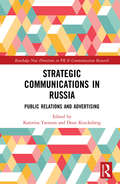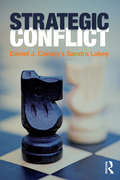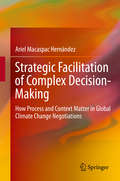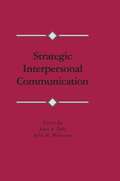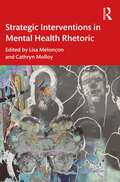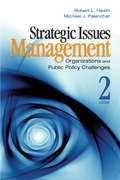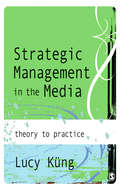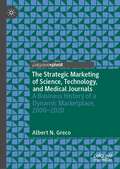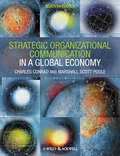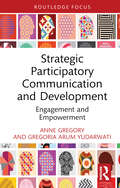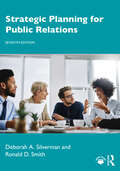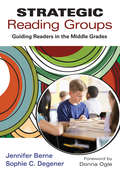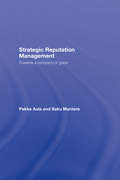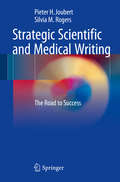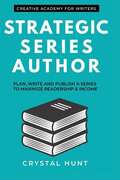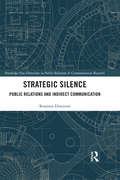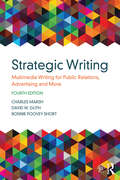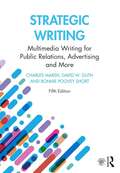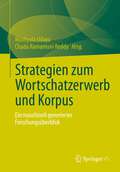- Table View
- List View
The Strategic Communication Imperative: For Mid- and Long-Term Issues Management
by James MahoneyThis book proposes a model for directly aligning strategic communication with organisational business planning to enable effective management of mid- to long-term organisational issues. It argues that current conceptualisations of strategic communication need to be extended to locate it more precisely within definitions of strategy and as an essential element of mid- and long-term business planning. This approach re-positions strategic issues communication in a professional practice dimension that has a specific focus on issues that do not immediately impact on an organisation’s ability to achieve its day-to-day business goals. Full of contemporary examples from business, and including a thorough explanation of how the model can be applied in professional practice, the book will prove illuminating reading for scholars, students, and professionals alike.
Strategic Communication in a Global Crisis: National and International Responses to the COVID-19 Pandemic (Routledge New Directions in PR & Communication Research)
by Ralph Tench Juan Meng Ángeles MorenoThis edited volume makes a unique and timely contribution by exploring in depth the topic of strategic communication and COVID-19 from a global perspective. It’s widely agreed that effective and timely communication and leadership are crucial to the successful management of any pandemic. With the ongoing and possibly long-lasting impact COVID-19 has generated to many aspects of communication and multiple sectors of our societies, it is critical to explore the role of strategic communication in change management during the COVID-19 pandemic and beyond. Therefore, this book addresses such a need and is thoroughly grounded in rich empirical evidence gained through a global study of COVID-19 communication experiences and strategies. In the second half of 2020, a transnational team of senior researchers conducted research to investigate COVID-19 communications (COM-COVID-19) in different countries, representing Europe, Africa, Latin America, North America, South America, and Asia. The results presented in this book provide a compelling, current picture of the COVID-19 pandemic and strategic communication globally. Chapters individually explore the national and regional experiences and discuss relevant success and failures of pandemic communication and specific learning from the 2020/21 crises. By emphasizing the discussion on key communication channels, sources of information, facts and concerns as related to the COVID-19 pandemic, the editors call for actions to develop effective strategies within unique national contexts, which can shed light on global expectations on necessary public health responses and communication. This book is written for scholars, educators and professionals in communication, public relations, strategic communication and corporate communication. It is also appropriate to use this book as a supplementary text for advanced undergraduate and graduate courses on relevant courses.
Strategic Communication, Social Media and Democracy: The challenge of the digital naturals (Routledge New Directions in PR & Communication Research)
by W. Timothy Coombs, Jesper Falkheimer, Mats Heide and Philip YoungToday almost everyone in the developed world spends time online and anyone involved in strategic communication must think digitally. The magnitude of change may be up for debate but the trend is unstoppable, dramatically reconfiguring business models, organisational structures and even the practice of democracy. Strategic Communication, Social Media and Democracy provides a wholly new framework for understanding this reality, a reality that is transforming the way both practitioners and theoreticians navigate this fast-moving environment. Firmly rooted in empirical research, and resisting the lure of over-optimistic communication dreams, it explores both the potential that social media offers for changing the relationships between organisations and stakeholders, and critically analyses what has been achieved so far. This innovative text will be of great interest to researchers, educators and advanced students in strategic communications, public relations, corporate communication, new media, social media and communication management.
Strategic Communication Theory and Practice: The Cocreational Model
by Carl Botan<p>Communication is a core function of every human organization so when you work with communication you are working with the very core of the organization. Written for students, academics, and professionals, Strategic Communication Theory and Practice: The Cocreational Model argues for a single unified field of strategic communication based in the three large core subfields of public relations, marketing communication, and health communication, as well as strategic communicators working in many other subfields such as political communication, issues management, crisis communication, risk communication, environmental and science communication, social movements, counter terrorism communication, public diplomacy, public safety and disaster management, and others. Strategic Communication Theory and Practice is built around a cocreational model that shifts the focus from organizational needs and the messages crafted to achieve them, to a publics-centered view placing publics and their ability to cocreate new meanings squarely in the center of strategic communication theory and practice. The author—a noted expert in the field—outlines the theories, campaign strategies, common issues, and cutting edge challenges facing strategic communication, including the role of social media, ethics, and intercultural strategic communication. <p>As the author explains, the term "strategic communication" properly refers only to the planned campaigns that grow out of research and understanding what publics think and want. This vital resource answers the questions of whether, and how, strategic-level skills can be used across fields.</p>
Strategic Communication Theory and Practice: The Cocreational Model
by Carl H. BotanA guide to strategic communication that can be applied across a range of subfields at all three levels—grand strategic, strategic, and tactical communication Communication is a core function of every human organization so when you work with communication you are working with the very core of the organization. Written for students, academics, and professionals, Strategic Communication Theory and Practice: The Cocreational Model argues for a single unified field of strategic communication based in the three large core subfields of public relations, marketing communication, and health communication, as well as strategic communicators working in many other subfields such as political communication, issues management, crisis communication, risk communication, environmental and science communication, social movements, counter terrorism communication, public diplomacy, public safety and disaster management, and others. Strategic Communication Theory and Practice is built around a cocreational model that shifts the focus from organizational needs and the messages crafted to achieve them, to a publics-centered view placing publics and their ability to cocreate new meanings squarely in the center of strategic communication theory and practice. The author—a noted expert in the field—outlines the theories, campaign strategies, common issues, and cutting edge challenges facing strategic communication, including the role of social media, ethics, and intercultural strategic communication. As the author explains, the term "strategic communication" properly refers only to the planned campaigns that grow out of research and understanding what publics think and want. This vital resource answers the questions of whether, and how, strategic-level skills can be used across fields, as it: Explores the role of theory and the cocreational meta-theory in strategic communication Outlines ethical practices and problems in the field Includes information on basic campaign strategies Offers the most recent information on risk communication, preparedness and terrorism communication, and employment in strategic communication Redefines major concepts, such as publics, from a cocreational perspective
Strategic Communications in Africa: The Sub-Saharan Context (Routledge New Directions in PR & Communication Research)
by Hugh MangeyaStrategic communication is a pre-requisite for the achievement of organisational goals and an effective strategic communication plan is vital for organisational success. However, systems and models dominant in the west may not necessarily be best suited for the sub-Saharan Africa reality, where many organisations lack adequate financial resources to develop and implement an effective strategic communication plan. This book examines current practices in sub-Saharan Africa, as well as the challenges faced and the intersection with culture. The Editors package inspiring debates, experiences and insights relating to strategic communication in all types of institutions, including private and public sector organisations, governmental organisations and NGOs, political parties as well as social movements in the sub-Saharan context. It explores how culture is integral to the attainment of strategic communication goals, and diverse case studies across socio-economic contexts offer insights into the successes of organisations across Africa, including Zimbabwe, South Africa, Tanzania, Lesotho, Zambia, and Nigeria. This unique edited collection is a valuable resource for worldwide scholars, researchers and students of strategic communication and organisational studies, as well as related fields including public relations, advertising, political and health communication, and international studies.
Strategic Communications in Russia: Public Relations and Advertising (Routledge New Directions in PR & Communication Research)
by Tsetsura, Katerina / Kruckeberg, DeanThis book serves as a reader exploring the scholarly inquiry, professional education, and practice of Russian public relations and advertising in multiple contexts. It examines significant parts of what can be encompassed under the umbrella of strategic communications, including public relations and advertising, rather than investigating all areas of communication in Russia. Within the context of Russia’s history, culture, and ideology, the book begins by tracing the development of communication as a field, as a discipline, and as a social institution in Russia. It then samples current studies in Russian strategic communications, examining this professional specialization’s current state and likely future directions. The book’s authors are mostly Russians who are experts in their specializations. Chapters are predicated upon the premise that this is an exciting time of great opportunity for Russian strategic communications. However, in Russia, exploiting such opportunities for strategic communications scholarship, education, and professional practice presents challenges within the context of that nation’s cultural, historical, and ideological heritage that presently may be unique. The book concludes with a prognosis of the future of Russian strategic communications. The book is recommended reading for a worldwide audience of strategic communications scholars, educators, students, and practitioners. Such readers will find the book of interest and of unique value as the book will help them to better understand, appreciate, and respect Russian strategic communications, its genesis, and present state.
Strategic Conflict (Routledge Communication Series)
by Daniel J. Canary Sandra LakeyStrategic Conflict offers a research-based, accessible analysis of how people can manage conflict productively. Moving beyond the basics of conflict, it examines interpersonal situations in which conflict occurs and promotes strategic communicative responses based on the latest theoretical research. Daniel J. Canary and his colleagues add personal observations, media examples, and samples of actual interaction to provide concrete illustrations of the research findings. This comprehensive volume provides students with the tools to understand conflict in real-world contexts. ?
Strategic Facilitation of Complex Decision-Making
by Ariel Macaspac HernándezThis book provides theoretical and practical insights for effective decision making in situations that involve various types of conflict cleavages. Embedding historical analysis, negotiation analysis, political scientific analysis and game theoretical analysis in an integrated analytical framework allows a comprehensive perspective on various dilemmas and self-enforcing dynamics that inhibit decision making. The conceptualization of strategic facilitation highlights the value of leadership, chairmanship and the role of threshold states in facilitating decision making as the global climate change negotiations unfolds.
Strategic Interpersonal Communication (Routledge Communication Series)
by John A. Daly John M. WiemannThis book discusses how people go about achieving their social goals through human symbolic interaction. The editors' collective presumption is that there are more or less typical ways that people attempt to obtain desired outcomes -- be they persuasive, informative, conflictive, or the like -- through communication. Representing a first summary of research done by scholars, primarily in the communication discipline, this volume seeks to identify and understand how it is that people achieve what they want through social interaction. Under the very broad label of strategies, this research has sought to: * identify critical social goals such as gaining compliance, generating affinity, resolving social conflict, and offering information; * specify, for each goal, the ways, or strategies, by which people can go about achieving these goals; * determine predictors of strategy selection -- that is, why does a person opt for one strategy over others to obtain the desired end? The research also reflects the attention the field of communication has given to strategy issues in the past 15 years. The chapters describe research on the ways in which people achieve different goals, and summarize existing research and theory on the attainment of social goals. Readers will gain insight into many of the issues that exist regardless of the strategy being discussed. Thus, this volume may not include chapters on topics such as ways people elicit or offer disclosure, ways people demonstrate anger, or ways people create guilt, but the issues that appear consistently throughout the various chapters should apply equally to these. Finally, the essays in this volume provide not only a summary of what has been accomplished to date, but also an initial theoretic map for future research concerning strategic interpersonal communication.
Strategic Interventions in Mental Health Rhetoric
by Lisa MelonçonOffering rhetorically informed strategic interventions, this innovative collection moves beyond critiques of mental health issues, problems, and care. With sections that focus on methodological, cultural and legal, and pedagogical interventions, readers will find an engaging discussion of a discrete mental health phenomenon as well as a clear interventional takeaway in each chapter. Contributors make use of critical discourse analyses, ethnographic inquiries, autoethnographic inquiries, case studies, and textual analyses to engage such mental health research topics as postpartum depression among Chinese mothers; insanity pleas; anosognosia; issues of intimacy, access, and embodiment in research projects; community support groups; Black mental health; women in Alcoholics Anonymous; and mental health in faculty workshops and university online health tools. The authors and editors create scholarship on mental health that explicitly builds productive methodological, theoretical, and practical bridges among scholars and teachers in the various specialties of writing and communication. This collection will interest scholars, students, and practitioners in health and medical humanities; rhetoric of health and medicine; health communication; medical anthropology; scientific and technical communication; disability studies; and rhetorical studies generally.
Strategic Issues Management: Organizations and Public Policy Challenges
by Robert L. Heath Michael J. PalencharStrategic Issues Management explores the strategic planning options that organizations can employ to address crucial public policy issues, engage in collaborative decision making, get the organization's "house" in order, engage in tough defense and smart offense, and monitor opinion changes that affect public policy. In this fully updated Second Edition, authors Robert L. Heath and Michael J. Palenchar offer practical, actionable guidance that readers can apply to organizations from large Fortune 500 companies to nongovernmental organizations and start-up high tech companies.
Strategic Management in the Media
by Lucy Kung"This book provides vital insights into the elements of strategy and their application to media firms. Solidly grounded in theory but not pedantic, it is essential reading for those who make or wish to comprehend choices of media companies." Robert Picard, University of Jönköping, Sweden "Insightful, contextually analytical, yet easy to comprehend, Strategic Management in the Media successfully applies the adaptive and interpretative areas of strategic theory in the media sectors. It provides a unique perspective in which common themes linking media strategy and industry environment are thoughtfully discussed." Sylvia M. Chan-Olmsted, University of Florida "...an invaluable asset for students of media management. The use of pertinent examples and case studies throughout brings the analysis to life and contributes to a highly readable introduction." Gillian Doyle, University of Glasgow This book is a comprehensive, accessible and expert introduction to strategy within a media management context. It is divided into two parts - part one providess an introduction to and overview of the media industry from a strategic management perspective, looking in detail at the sectors that together comprise the industry - newspaper, book and magazine publishing, music, radio and television - and the strategic forces at work in each. This provides the foundation for part two, which analyses a number of strategic topics central to the media sector, such as technological change, organisational structure, leadership, and creativity and innovation. The chapters follow the same structure: the relevant theory is outlined, its application to the media industry is discussed, and case studies from the media industry are used to illustrate the theory and illuminate its relevance for the media field. The cases and examples used come from all sectors of the industry and a range of geographic regions and include News Corporation, Endemol, BBC, Bertelsmann, CNN, MTV, Disney and Pixar.
The Strategic Marketing of Science, Technology, and Medical Journals: A Business History of a Dynamic Marketplace, 2000–2020
by Albert N. GrecoThis book analyzes the various economic and marketing strategies utilized by the five major STM commercial scholarly journal publishers since 2000. This period has witnessed tremendous economic, marketing, and technological growth including the migration from a print only to a hybrid publishing format. With this growth, the industry has also seen the rise of open access publishing, copyright challenges by websites such as Sci-Hub, the emergence of sharing platforms such as ResearchGate and Academia.edu, as well as the impact of Plan S on publishers, universities, and authors. Given this incredible rate of change across the industry, the author explores the diverse strategies and structures created by the largest STm publishers to decipher their effectiveness in addressing technological, ethical, and copyright issues. Also, he examines how mergers and acquisitions diversified operations, such Elsevier's acquisition of Bepress, SSRN, and SCOPUS, among other platforms. Scrutinizing the different managerial, marketing, technology, and economic-financial strategies crafted by scholarly journal publishers between 2000-2020, this book offers a comprehensive assessment of the industry's attempts to identify, understand, cope with, and minimize or defeat the herculean threats to its business model.
Strategic Organizational Communication: In a Global Economy
by Charles Conrad Marshall Scott PooleSurveying a wide variety of disciplines, this fully-revised 7th edition offers a sophisticated and engaging treatment of the rapidly expanding field of organizational communication Places organizations and organizational communication within a broader social, economic, and cultural context Applies a global perspective throughout, including thoughtful consideration of non-Western forms of leadership, as well as global economic contexts Offers a level of sophistication and integration of ideas from a variety of disciplines that makes this treatment definitive Updated in the seventh edition: Coverage of recent events and their ethical dimensions, including the bank crisis and bailouts in the US and UK Offers a nuanced, in-depth discussion of technology, and a new chapter on organizational change Includes new and revised case studies for a fresh view on perennial topics, incorporating a global focus throughout Online Instructors' Manual, including sample syllabi, tips for using the case studies, test questions, and supplemental case studies
Strategic Participatory Communication and Development: Engagement and Empowerment
by Anne Gregory Gregoria Arum YudarwatiThere has been a recent shift in the nature of public engagement from a culture of paternalism and control towards a public-centred approach involving collaboration and co-creation. This book draws on public relations and development communication insights to build a new community engagement model for public sector organisations who wish to engage with rural communities in developing countries. This theoretical model also offers a practical framework for Government in particular to engage with and empower rural communities as they adopt and exploit infrastructure developments. The outcome is mutual benefit.By examining in detail how Government communicates with rural communities on renewable energy infrastructure projects in Indonesia, and underpinned by empirical research with those communities, this new participatory framework has been developed. It envisages progressive empowerment of rural communities as Government encourages active engagement on the installation and exploitation of renewable energy. This entails encouraging communities to determine for themselves their uses of sustainable energy sources and to take ownership of a co-determined future. In so doing, the Government itself is more likely to achieve its own renewable energy commitments.Research-based and combining theory with practice, this thought-provoking book will be welcomed by strategic communication and public relations scholars and practitioners alike.
Strategic Planning for Public Relations
by Deborah A. Silverman Ronald D. SmithThe seventh edition of Strategic Planning for Public Relations maintains its status as a leading text to guide students in developing successful public relations campaigns.Deborah Silverman and Ronald Smith bring their experience as instructors and public relations professionals to the book, providing clear, step-by-step guidance on how to plan and implement strategic communications campaigns. This new edition includes diverse examples of current cases along with classic cases that stand the test of time. It includes new “Ethics Minutes” scenarios in each step, a new research step, and examples of award-winning public relations campaigns. It also significantly increases information on social media and features a reformatting of the tactics step into four separate parts based on the PESO model (paid media, earned media, shared media, and owned media).As a leader in teaching public relations strategy, this text is ideal for students in upper division undergraduate and graduate courses in public relations strategy and campaigns.Complementing the book are online resources for both students and instructors. For students: step overviews, useful links to professional organizations and resources, checklists for the ten steps in the planning process, and two sample campaigns. For instructors: an instructors’ manual, PowerPoint slides, sample syllabi, a critique evaluation worksheet, and checklists for the ten steps in the planning process. For these online resources, please visit www.routledge.com/9781032391168 .
Strategic Reading Groups: Guiding Readers in the Middle Grades
by Jennifer I. Berne Sophie C. DegenerDifferentiated reading instruction: An effective model for the middle grades Strategic grouping can transform reading instruction in the middle grades from a hit-or-miss learning experience to a targeted, responsive one. This book features a practical and field-tested model for small-group differentiated reading instruction in Grades 4–8. The authors offer a clear, detailed discussion of how to position this instruction inside middle school language arts or reading classrooms and simple, effective strategies for classroom management, groupings, and assessment. This text explains how to: Balance brief strategic reading lessons with whole-class work Structure and guide reading groups consistently Assess students before and during reading groups Cue students and gauge understanding as they read
Strategic Reputation Management: Towards A Company of Good
by Pekka Aula Saku MantereStrategic Reputation Management examines the ways in which organizations achieve "goodness" through reputation, reputation management and reputation strategies. It presents a contemporary model of strategic reputation management, helping organizations and stakeholders to analyze the business environment as a communicative field of symbols and meanings in which the organization is built or destroyed. Authors Pekka Aula and Saku Mantere introduce the eight generic reputation strategies, through which organizations can organize their stakeholder relationships in various ways. They illustrate their arguments using real-world examples and studies, from the Finnish Ski Association to Philip Morris International.This book serves as required reading in advanced courses covering public relations practice, advanced topics in PR, corporate communication, management, and marketing. Professionals working in PR, business, management and marketing will also find much of interest in this volume.
Strategic Scientific and Medical Writing
by Pieter H. Joubert Silvia M. RogersA document may be based on accurate medical and scientific information, follow guidelines precisely, and be well written in clear and correct language, but may still fail to achieve its objectives. The strategic approach described in this book will help you to turn good medical and scientific writing into successful writing. It describes clearly and concisely how to identify the target audience and the desired outcome, and how to construct key messages for a wide spectrum of documents. Irrespective of your level of expertise and your seniority in the pharmaceutical, regulatory, or academic environment, this book is an essential addition to your supporting library. The authors share with you many years of combined experience in the pharmaceutical and academic environment and in the writing of successful outcome-driven documents.
Strategic Series Author: Plan, Write and Publish a Series to Maximize Readership and Income (Creative Academy Guides for Writers Series)
by Crystal HuntWriting series can be a great way to level up your author career, create a more stable writing income, and create a devoted fanbase. It's also challenging, and can be overwhelming if you're not prepared. Series authors need to consider many things that standalone title authors don't have to worry about. And everything is exponentially more complex once you're tackling more than one book! You might be wondering: What kind of series should I write? Which details do I need to keep track of? How much advance planning should I do? Is publishing strategy different for a series vs standalone titles? How can I get the most bang for my buck in marketing and promotion Experienced series author Crystal Hunt will help you answer all these questions and more with this combination strategy manual and exercises that will get you applying what you've learned to your own series project. Whether you're a seasoned series author, or just starting to explore your options and thinking a series might be a good next step for you, this book can help you write and publish your series smarter from ideas through publication and promotion! This is the third book in the Creative Academy Guides for Writers series. Be sure to check out the rest of the guides for writers in this series.
Strategic Silence: Public Relations and Indirect Communication (Routledge New Directions in PR & Communication Research)
by Roumen DimitrovMainstream public relations overvalues noise, sound and voice in public communication. But how can we explain that while practitioners use silence on a daily basis, academics have widely remained quiet on the subject? Why is silence habitually famed as inherently bad and unethical? Silence is neither separate from nor the opposite of communication. The inclusion of silence on a par with speech and non-verbal means is a vital element of any communication strategy; it opens it up for a new, complex and more reflective understanding of strategic silence as indirect communication. Drawing on a number of disciplines that see in silence what public relations academics have not yet, this book reveals forms of silence to inform public relations solutions in practice and theory. How do we manage silence? How can strategic silence increase the capacity of public relations as a change agent? Using a format of multiple short chapters and practice examples, this is the first book that discusses the concept of strategic silence, and its consequences for PR theory and practice. Applying silence to communication cases and issues in global societies, it will be of interest to scholars and researchers in public relations, strategic communications and communication studies.
Strategic Writing: Multimedia Writing for Public Relations, Advertising and More
by Charles Marsh David W. Guth Bonnie Poovey ShortIn its fourth edition, Strategic Writing emphasizes the goal-oriented mission of high-quality public relations and media writing with clear, concise instructions for more than 40 types of documents. This multidisciplinary text covers writing for public relations, advertising, sales and marketing, and business communication. In addition, it includes concise chapters on topics such as diversity, ethics and the legal aspects of strategic writing. Featuring a spiral binding, examples for each document and a user-friendly "recipe" approach, Strategic Writing is ideal for undergraduate PR or advertising writing classes that take an interdisciplinary approach. This new edition devotes new attention throughout to social media and writing in the digital realm, and features new and updated online resources for students and instructors.
Strategic Writing: Multimedia Writing for Public Relations, Advertising and More
by Charles Marsh David W. Guth Bonnie Poovey ShortThis practical, multidisciplinary text teaches high-quality public relations and media writing with clear, concise instructions for more than 40 types of documents. <p><p>Strategic Writing takes a reader-friendly "recipe" approach to writing in public relations, advertising, sales and marketing, and other business communication contexts, illustrated with examples of each type of document. With concise chapters on topics such as ethical and legal aspects of strategic writing, including diversity and inclusion, this thoroughly updated fifth edition also includes additional document samples and coverage of writing for various social media platforms. Packed with pedagogical resources, Strategic Writing offers instructors a complete, ready-to-use course. <p><p>It is an essential and adaptable textbook for undergraduate courses in public relations, advertising and strategic communication writing, particularly those that take a multidisciplinary and multimedia approach. <p><p>Strategic Writing is ideally suited for online courses. In addition to syllabi for both online and traditional courses, the instructor’s manual includes Tips for Teaching Strategic Writing Online. Those tips include easy guidelines for converting the book’s PowerPoint slides to videos with voiceovers for online lectures. The book’s recipe-with-examples approach enhances student self-instruction, particularly when combined with the companion website’s sample assignments and grading rubrics for every document.
Strategien zum Wortschatzerwerb und Korpus: Ein maschinell generierter Forschungsüberblick
by Muthyala Udaya Chada Ramamuni ReddyDieses Buch untersucht den Bereich der ESL/EFL-Wortschatz- und Korpusstudien aus fünf umfassenden Perspektiven: Erwerb, Strategien, IKT, Korpus und aktuelle Praktiken. Die fünf Abschnitte des Buches sind so gruppiert, dass eine ausgewogene Abdeckung der Beschreibungen, wie Vokabeln erworben werden, und der verschiedenen Strategien, die von Lernenden und Lehrenden eingesetzt werden, um den Wortschatz zu beherrschen, erreicht wird. Einer der Abschnitte befasst sich mit dem Einfluss der Informations- und Kommunikationstechnologien auf das Lernen und neue Lehrmethoden. Der Abschnitt über das Lehren und Lernen von Korpus und Wortschatz enthält Zusammenfassungen darüber, wie Korpora die Sprache der Lernenden sein können und wie sie sich direkt auf den Unterricht auswirken. Der letzte Abschnitt über aktuelle Praktiken und Forschung beleuchtet die von Lehrenden und Forschenden angewandten Praktiken bei der Entwicklung des Themas Wortschatz. Dieses Buch ist eine wertvolle Ressource für Forschende, Lehrende und Sprachmittler*innen, die sich für die Natur des Wortschatzes im ESL/EFL-Lehr- und Lernkontext interessieren.
